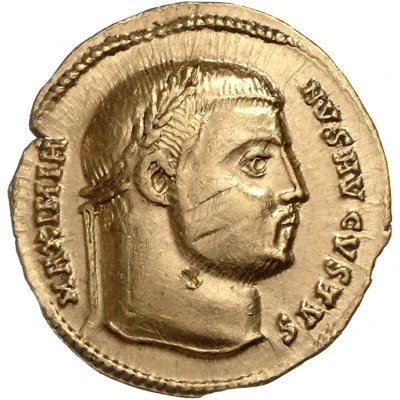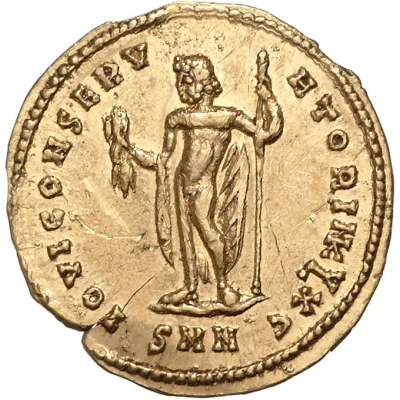


© Münzkabinett - Staatliche Museen zu Berlin (CC BY-SA 4.0)
Aureus - Galerius Maximianus IOVI CONSERVATORI NK Y XC; Nicomedia
| Gold | 5.33 g | 20 mm |
| Issuer | Rome › Roman Empire (27 BC - 395 AD) |
|---|---|
| Emperor | Galerius (Gaius Galerius Valerius Maximianus) (305-311) |
| Type | Standard circulation coin |
| Years | 307-308 |
| Value | Aureus (10) |
| Currency | Argenteus, Reform of Diocletian (AD 293/301 – 310/324) |
| Composition | Gold |
| Weight | 5.33 g |
| Diameter | 20 mm |
| Shape | Round (irregular) |
| Technique | Hammered |
| Orientation | Variable alignment ↺ |
| Demonetized | Yes |
| Updated | 2024-10-05 |
| Numista | N#388201 |
|---|---|
| Rarity index | 100% |
Reverse
Jupiter, naked, except for cloak over left shoulder and right arm, standing front, head left, holding vertical sceptre in left hand and thunderbolt in right hand.
Inscription note: NK and Y are stylised.
Script: Latin
Lettering:
IOVI CONSERVATORI NK Y XC
SMN
Comment
Weight varies from 5.27-5.33g
Interesting fact
The Aureus - Galerius Maximianus (IOVI CONSERVATORI NK Y XC; Nicomedia) (307-308) coin was part of a series of coins issued by the Roman Empire during the reign of Emperor Galerius, who ruled from 293 to 311 AD. This coin was minted in Nicomedia, which is now modern-day İzmit in Turkey, and it features an image of Jupiter, the Roman god of the sky and thunder, on one side, and an image of Galerius on the other side. The coin was made of gold and weighed around 5.33 grams. It's interesting to note that during Galerius' reign, the Roman Empire was facing economic challenges, and the value of the Roman currency was declining. To address this issue, Galerius introduced a new system of taxation and issued a new series of coins, including the Aureus - Galerius Maximianus coin, which was meant to stabilize the economy and restore confidence in the Roman currency. Despite these efforts, the Roman Empire continued to face economic challenges, and the value of the currency continued to decline over time.